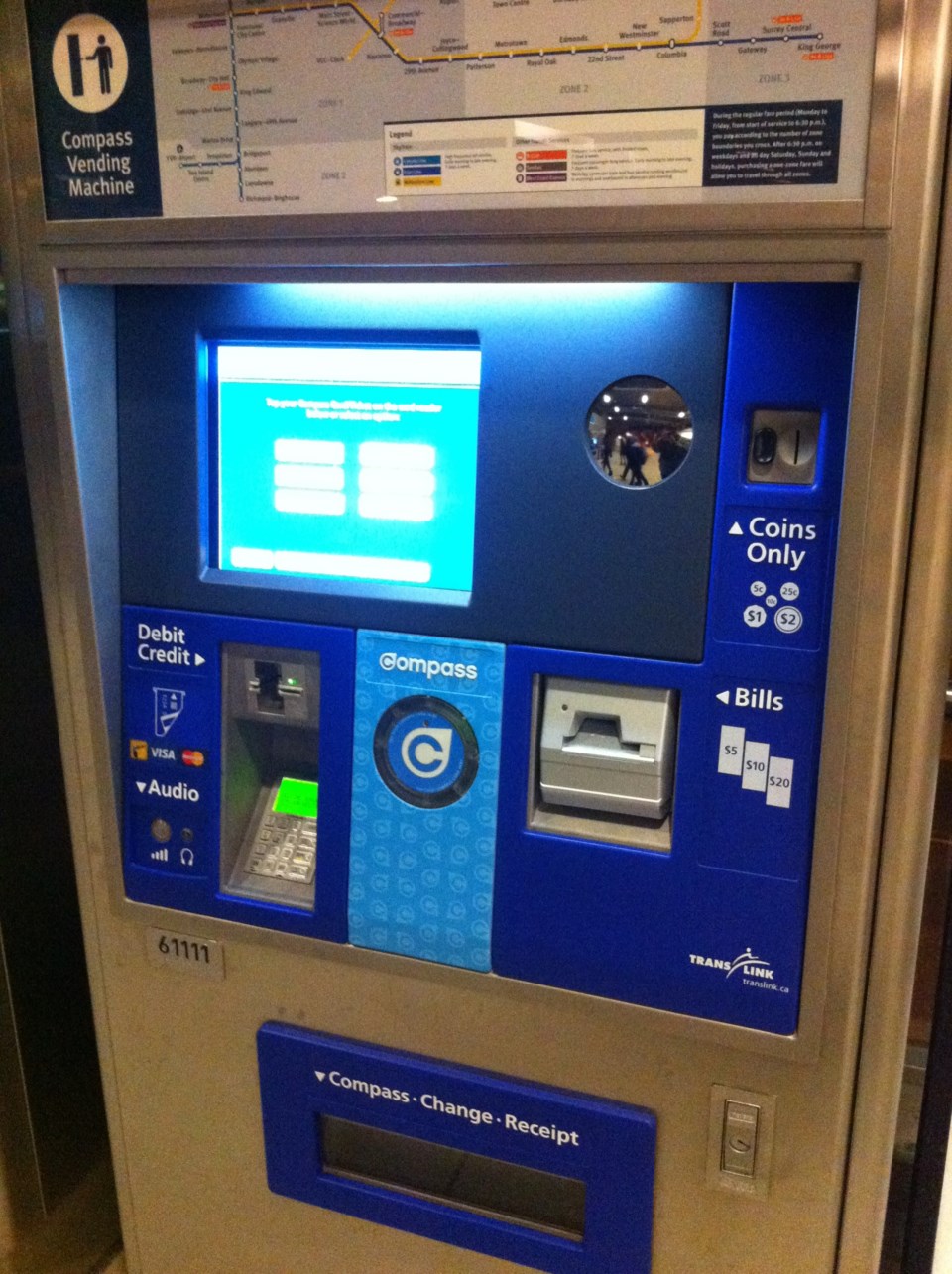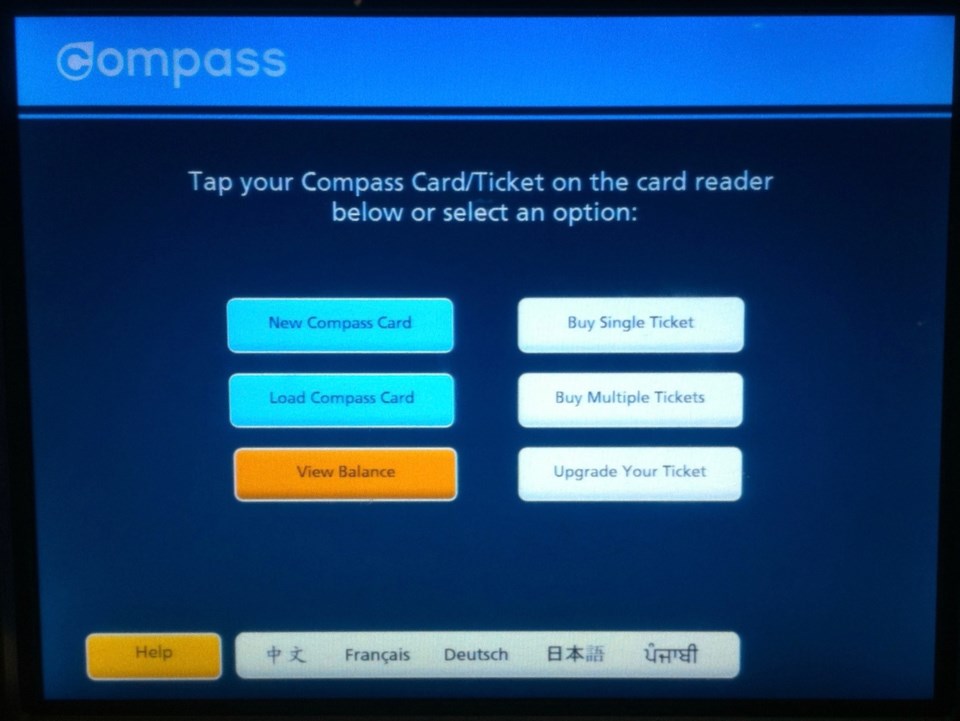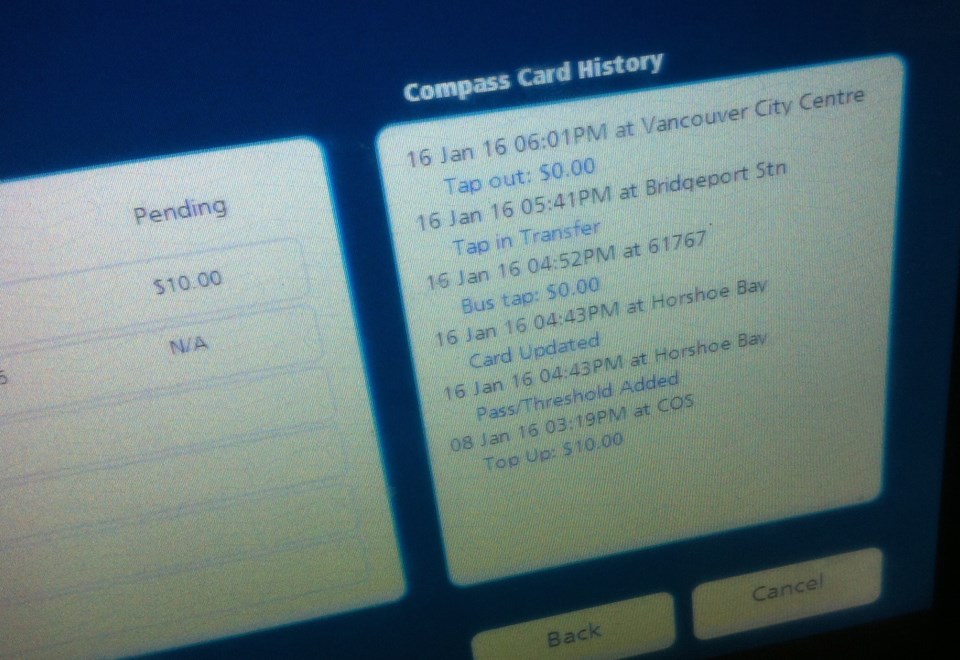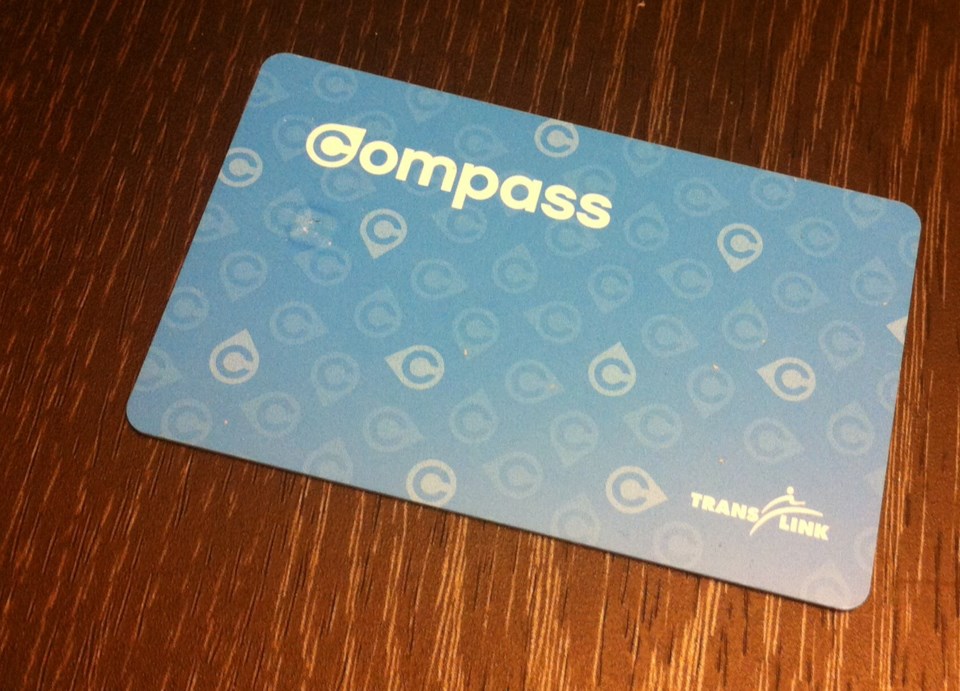How do you ride Vancouver transit with a Compass card? The short answer is: buy a Compass card and tap it on the blue Compass card logo when you board a Metro Vancouver bus or approach a train or SeaBus fare gate.
But behind that simple tap are a lot of details, and I review some of them here.
After years of testing and delay, TransLink, Metro Vancouver’s public transit system, fully rolled out its Compass fare payment system in January.
I bought my Compass card online while at home in Victoria, reasoning that it would be handy to have it before I arrived in Vancouver. I didn’t want to go searching for a vending machine, or to line up at one.
Go to this Compass card website; you need a credit card. Pay a $6 deposit for the Compass card and buy “value” that goes toward fares, or buy up to three day passes for $9.75 each. Monthly passes are also an option. More details are at the website, and at the entertaining Ask Compass website, where dozens of arcane questions are posed and most are cheerfully answered.
As you use up the value or the passes, add more by going to the Compass website or by going to a Compass vending machine (photos below).
My Compass card arrived in the mail about a week after ordering. There is no extra charge for mailing.
With card in pocket, I rode a Victoria transit bus to Swartz Bay terminal and then B.C. Ferries to Tsawwassen terminal.
At Tsawwassen terminal, in the vending machines area of the arrivals section, next to the pop and chips, there are two Compass vending machines, which were installed in October. Their role is not obvious for visitors unfamiliar with Metro Vancouver’s transit system. Each machine has a sign at the top that says “Compass Vending Machine” — not something more to the point like Pay Transit Fares Here.
Of the dozens of people who poured off the ferry and lined up for the 620 bus that goes to Bridgeport station, I only saw one go up to the machine. Many people, like me, already had a Compass card. But many others fumbled with coins to pay the exact-change fare as they boarded the bus, often asking the driver how much they had to put in the farebox.
On my bus, a Compass card reader was at my waist level, on the windshield side. Depending on bus design, it can be elsewhere near the driver.
You tap your card on a blue patch with the Compass “C” logo, which is below a green screen with an arrow pointing down that says Tap Card. Hold your card flat against the blue patch for about a second. Touching the blue patch with the edge of the card does not appear to work. If the tap is a success, a checkmark appears on the green screen and there’s a beep.
Here’s a TransLink video showing how you should tap.
On buses, $2.10 will be deducted from the value on your Compass card. If you have loaded a day pass, the day pass will be activated. If you have both a day pass and dollar amounts loaded on your card, the day pass will be deducted first. If you were hoping to just pay the $2.10 fare and use the day pass the next day, you’ll need two Compass cards, one with just cash value, the other with the day pass.
Fares on buses are all one zone, all day, every day. You tap to board (tap in), but you do not tap when you get off (tap out), even though there are card readers at the back doors. TransLink had wanted to charge multi-zone fares on buses, using your tap out location to determine how far you had travelled. But the tap out technology, which needs to connect to a distant computer system, did not work reliably on buses.
Tap out, however, is required when you ride the trains and the SeaBus.
At stations, you tap in at a fare gate, on the blue patch on the right side. The value remaining on your card briefly flashes on a screen. The gate, two plastic doors, opens. During the introductory period for Compass, at least one gate will be left open for people using old-style paper tickets. When you tap in, the fare for a three-zone trip (the maximum) is deducted. At your destination, you tap out at a fare gate. If you rode in just one zone or two zones, there’ll be a refund to your card.
(Based on an annoying experience in Paris, I’m inclined to wait for the person in front of me to tap and walk through before I tap. Fare evaders in Paris are known to hesitate at closed gates, and wait for bumbling tourists like me to slide in their ticket. They then walk through, while I fume behind the closed gate.)
There are Exit Ticket Machines at station exits. People can buy another fare if they lose their ticket or Compass card after they tap in. They’ll need to buy another fare to get out of the station once all fare gates are closed.
You save a bit of money when you use a Compass card, versus buying single Compass tickets (which you also tap on the blue reader).
A single one-zone ticket is $2.75, versus $2.10 if you use the card.
It’s $4 versus $3.15 for two zones, and $5.50 versus $4.20 for three zones.
I tried out the vending machines. They’re at all Canada Line, Expo Line and Millennium Line stations, the Tsawwassen and Horseshoe Bay ferry terminals, and Metro Vancouver London Drugs stores.
You can buy Compass cards, single tickets or day passes at the machines. A touch screen gives you options. They take credit cards, debit cards and cash — coins plus $5, $10 and $20 bills. I tried to buy a Compass card using my credit card, but was unsuccessful despite trying three machines. I slid my card into the credit card slot as instructed, but it was rejected. I suspect I didn’t understand the directions, which involved a yellow blinking light. There was a moment of panic when, after one rejection, I could not pull my card back out. I tugged and tugged and wiggled (the card that is), and it eventually came free. So, I ended up using cash to buy the Compass card. My credit card worked fine in other transactions that day, including at a B.C. Ferries ticket machine.
Using a Compass vending machine, you can see how much money is left on a card by selecting the View Balance button on the touch screen, and tapping your card on the blue reader. You’ll be shown the balance and also have the option of seeing where the card has been used. I found that to be a little disconcerting. TransLink has a record of where I’ve used my card, and that card is linked to my name and address. But there’s a way around that. You can buy a Compass card with cash, and not register it on the Compass card website. No name will be associated with the Compass card. If you register and lose your card, the money balance can be transferred to a new card; you don’t have that option if you don’t register.
To discourage fare evasion, transit officers with card readers patrol the system and may ask to scan your card to see if you have tapped in. They’ll also be able to see locations where the card has been recently used. Which is also disconcerting.
If you’re travelling on the Canada Line from the airport beyond Sea Island, you’ll be charged an additional $5 on top of the regular fare. It’s called AddFare, and it’s supposed to help pay for the spur line to the airport.
You can avoid the $5 surcharge by using FareSaver tickets, but they are being phased out and are no longer sold. The $5 surcharge will be added to single tickets and day passes purchased from machines at the three Sea Island stations — Airport, Sea Island Centre and Templeton. The $5 surcharge will also be applied if you use a Compass card with stored value.
But the $5 won’t be charged for monthly passes, day passes and single-use Compass tickets not purchased on Sea Island.
For Vancouver Islanders getting off a plane at YVR and wanting to ride public transit into town, the most practical way to avoid the $5 charge is to have a day pass already loaded onto a Compass card. Or have a friend bring a single-use ticket not purchased on Sea Island.
Or, just skip this surcharge-avoiding cheapness, and pay up.
More details about the confusing airport rules are here.
And why has nearly $200 million been spent on the Compass card system? The genesis appears to be provincial government unhappiness about fare evasion. Under the old system, there were no fare gates. Riders could just walk onto trains without having to show a ticket, unless they encountered a random check.
There was also a desire to better track how the transit system is being used so that TransLink officials can respond more effectively to changing travel patterns.
Here’s an explanation from Ask Compass.
And perspectives from Wikipedia and The Tyee.

Compass card vending machine

Compass vending machine purchase options

Compass vending machine screen shows card's travel history
- - -
- - -
Most-popular posts:
Eight years of riding an electric-assist bicycle almost every day
Why newer dishwashers run for an alarmingly long time
Most credit cards charge 2.5% for currency conversion; a few charge 0%
Why paying $720 for a phone can be a better deal than a 2-year contract
Tips to make applying for a passport a little easier
What a credit report reveals, and how to get yours
Do you know your Gulf Islands? Here's help memorizing 14 (of 200)
What happens when a cross-country Via train is 16 hours late
How to line up at busy Greater Victoria restaurants
Running a smartphone for $10 a month
Via rolls out rooms with double bed on Vancouver-Toronto train
To stay cool, leave house windows closed or open?
A guide to public toilets in downtown Victoria
How to block unwanted text messages
Why B.C. Hydro bills sting more on Vancouver Island
How to pronounce Ucluelet, Tsawwassen, and that outdoor gear place
How to travel between Victoria and Vancouver on public transit
- - -



